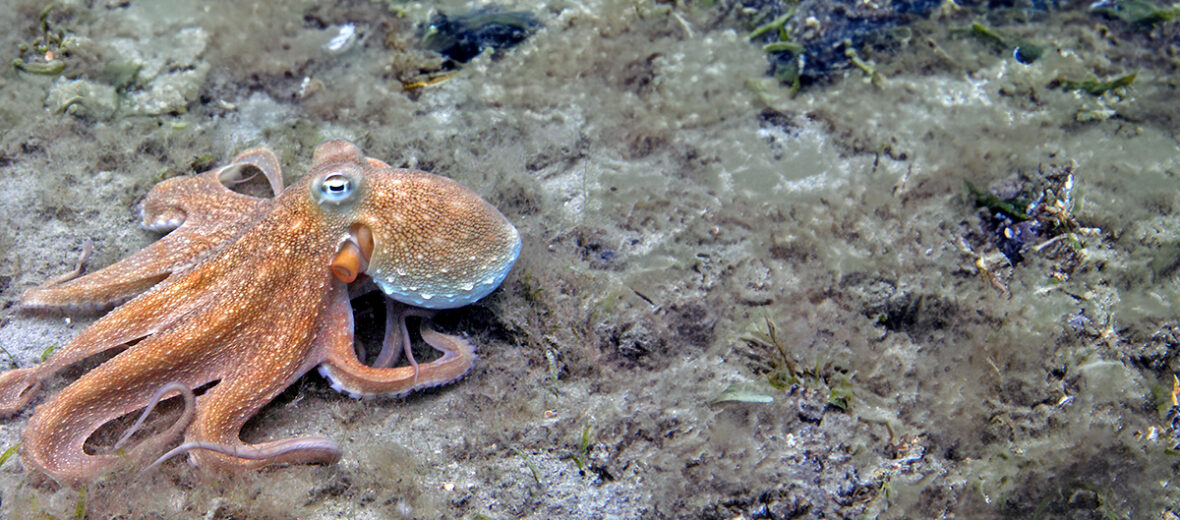
The common octopus is not only among the most studied of all octopuses, but among the most intelligent of them all. These octopuses hail from the eastern Atlantic, extending from the Mediterranean Sea, the southern coast of England, to the southern coast of South Africa, off the Azores, Canary Islands, Cape Verde Islands, and in the Western Atlantic. Even though they face the threats of overfishing and pollution, these critters are listed as Least Concern by the IUCN. Their population trend is unknown at this time.
First the Stats…
Scientific name: Octopus vulgaris
Weight: Up to 20 lbs.
Length: Up to 10 inches (mantle), and up to 3.3 foot arms
Lifespan: Up to 1.5 years
Now on to the Facts!
1.) Massive amounts of these cephalopods are caught by bottom trawls equalling up to 20 tons annually!
2.) They are crepuscular (active at dawn and dusk).
3.) Crayfish, crabs, bivalve mollusks, fish, and anything else that wanders across their path is on the menu.
4.) Like all cephalopods, they are masters of not only color change, but also skin texture changes as well. Color changes are capable via special chromatophores in their skin.
5.) They have a specialized, razor-sharp beak that is used to crack open shells and carapaces with ease.
But wait, there’s more on the common octopus!
6.) These octopuses are also venomous.
7.) With their roughly 500 million neurons dispersed throughout their mantle and arms, these creatures are highly intelligent (as comparable to canines).
Did you know…?
Common octopus venom contains digestive enzymes and proteinaceous neurotoxins that immobilize prey. But they aren’t harmful to humans.
8.) They are smart enough to navigate mazes, tell the differences of brightnesses, recognize individual humans, learn how to unscrew jars or even raid lobster traps. These clever critters have also been observed keeping gardens, where they will collect a variety of marine plant life and algae, with collections of shells and rocks.
9.) Common octopuses can also determine size, shape, and horizontal or vertical object orientations.
10.) The common octopus typically dwells in water no deeper than 660 feet.
But wait, there’s still more on the common octopus!
11.) Octopuses use a gills to breathe. The gills are made up of branchial ganglia and a series of folded lamellae. Their gill takes in up to 65%+/- of their total oxygen, with the remaining 35% +/- being absorbed through their thin and permeable skin.
12.) They have 3 hearts, 1 main 2-chambered heart responsible for sending oxygenated blood to the mantle & body, and 2 smaller branchial hearts, 1 next to each set of gills.
Did you know…?
The common octopus is a poikilothermic, eurythermic ectotherm. This means that it conforms to the ambient temperature. If the ambient water temperature is colder, their body temperature drops. If it gets warmer, they also adapt to the warmer temperatures.
13.) Spawning occurs from December – September.
14.) Females produce up to 500,000 eggs!
15.) Sadly, once the eggs are laid, the female stops eating and begins to self-mutilate, even tearing off her skin or eating her own arms to survive as long as she can. She is often dead before the eggs hatch.
Now a Short Common Octopus Video!
Be sure to share & comment below! Also, check out the Critter Science YouTube channel. Videos added regularly!
Want to suggest a critter for me to write about? Let me know here.
Some source material acquired from: Wikipedia & IUCN
Photo credit: iNaturalist



